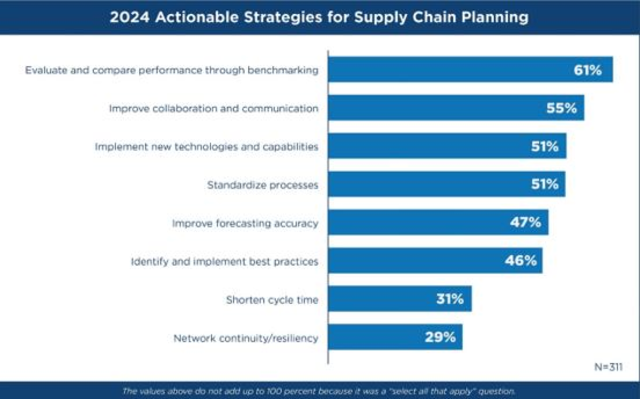
As part of the tenth annual Supply Chain Priorities and Challenges research, APQC asked 350+ supply chain professionals to identify where their organizations are investing resources, innovation, and hiring for supply chain in 2024. Supply chain planning remains the top area of focus across the end-to-end supply chain for at least the fifth consecutive year (selected by 90% of respondents). With the continued challenges facing supply chains—from geopolitical conflict to extreme weather events and beyond—that should be no surprise. After we highlight key focus areas for supply chain planning in 2024, we review the strategies that respondents find to be the most actionable for achieving their supply chain planning goals.
Integrated Business Planning is the Top Focus Area
To explore supply chain planning priorities in greater detail, APQC asked respondents to identify where they are focusing their efforts. Nearly half of respondents (49%) identified integrated business planning (IBP) as the top focus area within supply chain planning for 2024 (Figure 1).
 APQC Fig. 1
APQC Fig. 1
IBP has grown in importance since the 2023, when only 25% of respondents said it was a focus area for supply chain planning. This suggests that organizations are seeing greater value in aligning business goals and collaborating, both across their supply chains and with other key functional stakeholders in the business. Other top focus areas for supply chain planning include demand planning and forecasting, sales and operations planning, automation and digitization, and analytics and measurement.
Actionable Strategies for Supply Chain Planning
Supply chain leaders are focused on several actionable strategies to drive success in IBP and other key supply chain planning priorities (Figure 2). It is encouraging to see that evaluating and comparing performance through benchmarking is at the top of the list. In addition to quantitative benchmarks of supply chain measures and KPIs to identify gaps in performance, organizations also benefit from the qualitative benchmarking that takes place when supply chain professionals connect and share successful practices with each other.
 APQC Fig. 2
APQC Fig. 2
Collaboration is critical for Supply Chain Planning
Organizations in any industry will be well-served by improving collaboration and communication, which was the second most popular actionable strategy for supply chain planning. Good collaboration and communication are foundational for the ability to work efficiently across business areas and silos. This is especially important for processes like IBP and supply and demand forecasting, which involve numerous stakeholders and functional areas.
As further evidence of the importance of collaboration, 50% of respondents claim a lack of collaboration was one of the top obstacles standing in the way of improving supply chain processes. Respondents see a lack of collaboration as a bigger threat to supply chain improvement than poor data management (48% of respondents) or labor concerns like staffing shortages or strikes (45%).
Technology is An Opportunity and a Challenge
Technology is both an opportunity and an obstacle for many supply chain organizations. Implementing new technologies and capabilities is the third most popular actionable strategy for supply chain planning, and it’s not hard to see why. Emergent technologies like supplier risk notification systems are helping organizations to respond to disruptions more quickly, and in some cases even avoid it entirely. Solutions are increasingly incorporating artificial intelligence (AI) to provide key insights for complex processes like IBP and forecasting and planning.
At the same time, respondents also identified the implementation of new technologies as the top obstacle to improving supply chain processes (52% of respondents). This finding reflects the increased need for change management, as organizations reckon with the ways in which new technologies require process changes, new roles, new forms of governance, and more. Far from being ‘plug and play,’ many important forms of supply chain technology are only as good as the data, processes and governance that sit at their foundation.
Standardized Processes Help Build Resilience
With supply chains facing so much uncertainty in 2024, it may seem like standardized processes would be too rigid and inflexible to help organizations withstand disruption. In fact, the opposite is true. While no one can perfectly predict the future, organizations can and should develop a contingency playbook with different scenario plans for different triggers. Having a standardized set of processes that you can implement in response to different scenarios will help minimize the time your organization spends responding to disruption. Even if a scenario emerges that you did not previously plan for, you might still be able to adapt and implement an existing plan without having to start from scratch.
In 2024, supply chain organizations will continue to focus their attention and resources on supply chain planning. Cross-functional collaboration and communication are critical success factors for working effectively across business silos in support of better integrated business planning. Evolving technologies and capabilities provide deeper visibility across supply chains and drive more data-driven decision making. Standardized processes help to enable technology and help organizations better prepare for disruption. These strategies are all valuable, mutually reinforcing, and worthy of attention in 2024 and beyond.




![Pros To Know 2026 [color]](https://img.sdcexec.com/mindful/acbm/workspaces/default/uploads/2025/08/prostoknow-2026-color.mduFvhpgMk.png?auto=format%2Ccompress&bg=fff&fill-color=fff&fit=fill&h=100&q=70&w=100)







![Pros To Know 2026 [color]](https://img.sdcexec.com/mindful/acbm/workspaces/default/uploads/2025/08/prostoknow-2026-color.mduFvhpgMk.png?ar=16%3A9&auto=format%2Ccompress&bg=fff&fill-color=fff&fit=fill&h=135&q=70&w=240)





